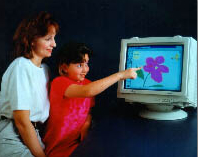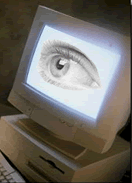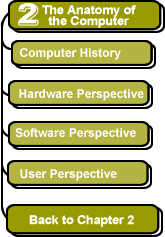
|
|
Chapter 2: The Anatomy of the Computer
The concepts and ideas with which you should be familiar are contained in the chapter 2 checklist. Print out the checklist to use as a study guide while working through the chapter.
GUI Culture
 The
lifetime of the current generation of college students coincides with
what might be called the "GUI Era of Computing." The rise
of the graphical user interface (or GUI)—the
"windowed" interfaces made popular by the Apple Macintosh
and Microsoft Windows over the decades since the mid-1980s—has
had an enormous impact on the culture of information technology.
The
lifetime of the current generation of college students coincides with
what might be called the "GUI Era of Computing." The rise
of the graphical user interface (or GUI)—the
"windowed" interfaces made popular by the Apple Macintosh
and Microsoft Windows over the decades since the mid-1980s—has
had an enormous impact on the culture of information technology.
In the era prior to the rise of the GUI, the term user was a synonym for computer programmer, because using a computer typically required the kind of understanding of information technology that we now associate with computer programmers. Thus, the human and computer interface was a very difficult one. This is largely attributable to the computer’s origin as a mathematical machine or "number cruncher": it was assumed that people with the knowledge necessary to understand the mathematical problems that computers were solving were capable of working with cryptic interfaces.
In contrast, graphical user interfaces have made it possible to use information technology without learning cryptic commands or even having any understanding of how computers work. The result has been an unprecedented diversity in the use of information technology. Around the world, people from all walks of life now use computers in a wonderful variety of ways.
 Thus
the change in the user interface has produced a change both in computer
use and also in the meaning of the term computer
user. Whereas "user" and "programmer"
were once synonymous, we now distinguish the two. In fact, the computer
industry has introduced the term end user to refer
to the typical computer user, because this person is at the end of the
process of producing information technology, uninvolved in its design,
and typically oblivious to how these technologies operate beyond and
“beneath” the graphical user interface that is presented.
The end user is expected to look no further than the illusion
on the screen.
Thus
the change in the user interface has produced a change both in computer
use and also in the meaning of the term computer
user. Whereas "user" and "programmer"
were once synonymous, we now distinguish the two. In fact, the computer
industry has introduced the term end user to refer
to the typical computer user, because this person is at the end of the
process of producing information technology, uninvolved in its design,
and typically oblivious to how these technologies operate beyond and
“beneath” the graphical user interface that is presented.
The end user is expected to look no further than the illusion
on the screen.
Thus, largely because of the graphical user interface, the information technology industry promotes the division of computer users into at least two groups, each with its own perspective on information technology:
-
end users, who are not expected—and, in some cases, not allowed—to have any understanding of how information technologies operate beneath the interface, and

-
experts, such as programmers and computer system administrators, who do understand the underlying operations and design of information technologies.

KEUs?
In a very real sense, one of the objectives of this course is to produce
an intermediate category: a knowledgeable end user
(a “KEU,” if you will), who interfaces with information
technology as an end user but also has some substantive understanding
of what computers really are and how they do what they do.
![]()
![]()
These pages were written by Steven H. VanderLeest and Jeffrey Nyhoff and edited by Nancy Zylstra
©2005 Calvin University (formerly Calvin College), All Rights Reserved
If you encounter technical errors, contact computing@calvin.edu.
